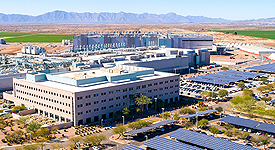July is Smart Irrigation Awareness Month and we would like to help you water smarter with our Smart Watering Series.
Use Cycle and Soak Watering
Cycle and Soak ensures grass gets the water it needs without losing gallons to the street. It promotes deeper roots that require less water and are more prepared for drought.
Learn more about Cycle and Soak.
Prevent Sprinkler Evaporation
Avoid watering between 8 a.m. and 8 p.m., when the sun is up, as much as 50% will be lost to evaporation.
Water for Stronger, Healthier and More Drought Tolerant Plants
- Water Longer and Less Often
It is hard for short runtimes to allow enough water to penetrate down to a plant's root zone. Watering longer, but less often provides enough water to penetrate into the root zone. Established grass should be watered no more than 2 to 3 times each week and most plants only need to be watered once a week.
Get monthly water frequency reminders by texting: WHENTOWATER to 33-222.
- Water for the Plant Type
Native and desert-adapted plants know how to deal with our weather and require less water more infrequently than non-native, high water using plants.
- Water for Plant Size
As plants grow, canopies expand; feeder roots are generally found at the canopy edge. Move drip emitters with canopy growth. Plant type determines root depth. Ensure watering to the appropriate depth.
Remember 1-2-3, one foot deep for groundcovers, cacti and annuals, two feet for shrubs, three feet for trees. See pages 3-4 of Landscape Watering by the Numbers for more information on application location and watering depths.
Change Watering Schedule to Match the Season
At least four times a year, revisit your watering schedule. For additional information on creating watering schedules for Arizona, refer to Landscape Watering by the Numbers.
Install a Smart Irrigation Controller
As noted above, watering schedules should match the season and plant type. To make this easier, there are now Smart Irrigation Controllers that take into account this information and automatically make scheduling adjustments based on plant type, soil type and weather conditions. Newer controllers can even send watering and leak notices to your phone. These controllers can save up to 20% on outdoor water use.
WaterSense approved devices are eligible for a rebate of up to $250.
Install Rain Sensors with Automatic Shut Off
Whether you have a smart or standard controller, installing a rain sensor/shut-off will allow your system to be automatically turned off in the event of rainfall.
Install Smart Water Applicators
- High Efficient spray nozzles for grass save 20%-30% on sprinkler water use
- Install pressure compensating drip emitters instead of sprays and micro-sprays for all trees, shrubs and potted plants
High-efficiency nozzles and emitters apply larger water droplets more slowly reducing evaporation and runoff allowing water to reach the ideal root-depth of the plant.
These eight items are the most common, easy to fix issues with your irrigation system to help you save water and save on your water bill.
- Missing sprinkler and drip heads
- Sprinkler heads that don’t pop up
- Tilted or misaligned sprinklers – Ensure water only sprays on grass
- Sprinkler shooting water
- Sprinkler gurgling water from the base
- Underground leaks
- Leaking valves
- Over-watering
Finding, fixing and repairing: Efficient irrigation takes routine maintenance.
-
Turn on watering system and walk through each zone
-
Check:
- Plumbing and valve boxes for signs of drips, puddling or excess moisture which indicate leaking equipment:
- For wet spots, puddled or bubbling water and signs of water damage (could indicate an underground leak)
- For misting sprinklers or overspray (may indicate too much pressure. Misting creates smaller water droplets increasing the amount of evaporation. Contact an irrigation professional to discuss pressure regulation options)
- For clogged, misaligned, tilted or broken sprinklers (prevent water from getting where it is needed, can cause runoff, and damage to hard surfaces)
- For clogged, misaligned or missing drip emitters (prevent water from getting where it is needed, can cause runoff, and damage to hard surfaces)
- Valves
- Wiring (look for signs of corrosion that could prevent proper operation)
- Solenoid (look for signs of swelling, cracks or corrosion)
- Controller
- Battery (back-up batteries should be replaced annually)
- Schedules – make sure there are no unintentional programs or start times programmed
- Wiring (look for signs of corrosion that could prevent proper operation)
- Plumbing and valve boxes for signs of drips, puddling or excess moisture which indicate leaking equipment:
-
Fix broken parts
- Repair damaged lines and leaking connections
- Fix or replace broken or clogged sprinklers
- Fix or replace broken or missing drip emitters (plug if the plant has died)
-
Align Sprinklers and drip
- Adjust sprinklers to avoid watering pavement and to ensure water reaches dry areas
- Replace incorrect or mismatched sprinkler nozzles (Application rates and patterns can be different for various manufacturers causing uneven watering)
- Fix sprinklers spaced too far apart or too close
-
Adjust the Watering Schedule if needed
-
Repeat
- At least annually (Spring), but quarterly would be best to ensure an efficient system.







